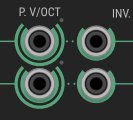Ok this is cool!
I can use sum instead of split. And continue with a summed mono signal.
I just tried it and it works fine! ![]() Thanks guys
Thanks guys
I’ve added a Polyphony section to https://vcvrack.com/manual/VoltageStandards.html#polyphony describing the exact behavior of polyphonic modules.
Jay puts foot in mouth: I really don’t see the big deal with a polyphonic modular synth
Jay takes foot out of mouth: Holy crap! How did I ever get by without VCV polyphony.
Thanks Andrew. To celebrate, I made a polyphonic Hammond B3 emulation in your honor!
Hi - just in case you didn’t know about Patchstorage…you may want to upload your patches there as well, for better exposure:
Thanks mixer!
I wonder if you could have different shapes for a polyphonic I/O plug widget? For example you could use something that looks like an XLR or DIN plug, rather than something that looks like a jack. I realise that module makers use their own graphics, but you could suggest a standard that polyphonic I/Os give you a clue that they’re polyphonic…?
Experimenting with that at the moment, slightly different socket designs for mono in / out & poly in / out, trivial to implement.
Another modular piece of software users different cables and I honestly think it looks terrible and too busy.
Clockwise starting from top left, mono out, mono in, poly in, poly out. Comments?

Rainbow Prism uses an extra partial ring around a jack to show it is polyphonic.

And I love how an opening on top means IN and an opening on the bottom means OUT, great design.
Just remembered for the first time.
Also GCC can vectorize loops quite often by
#pragma GCC ivdep
for(int i = 0; i < x; i++) {
// code here vectorized SIMD if z[i] not depends on z[i-1]
//otherwise old value is used as loop is indicated for parallelization
}